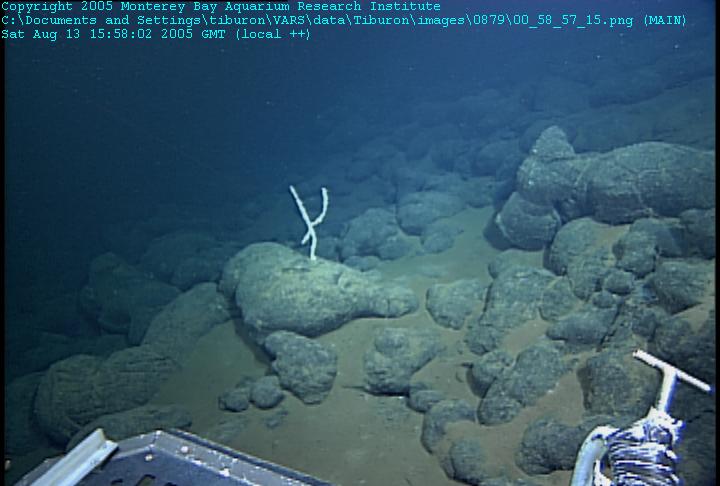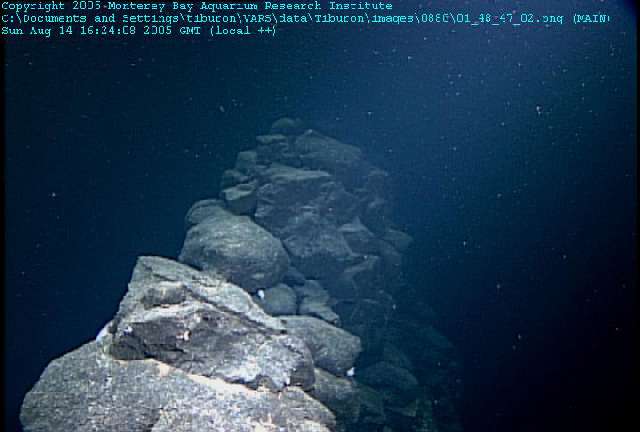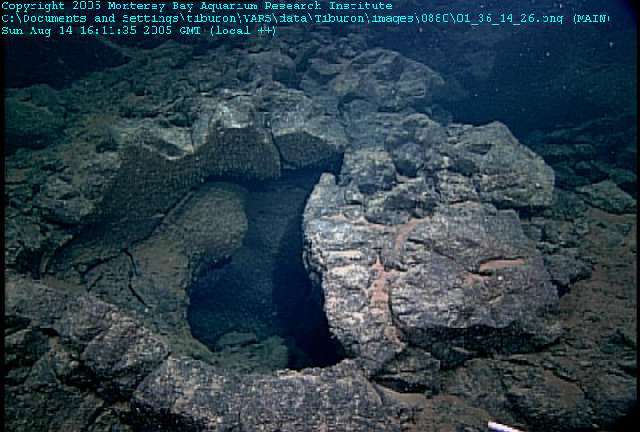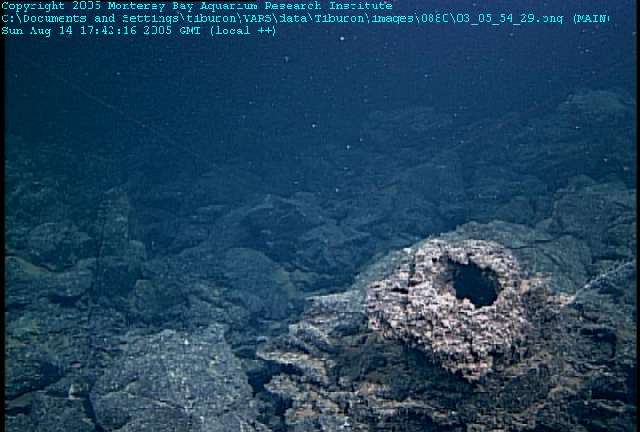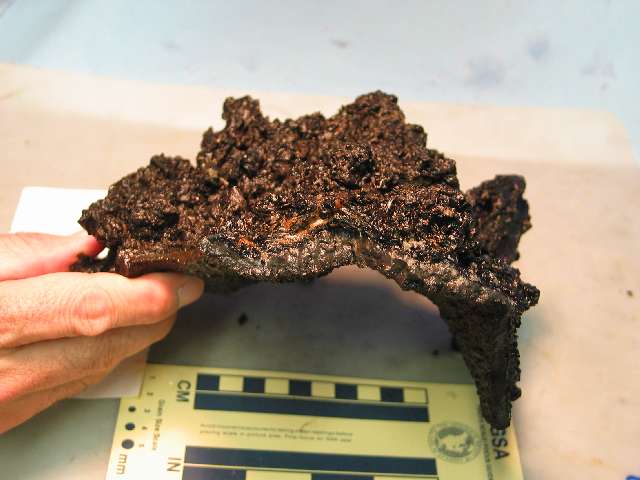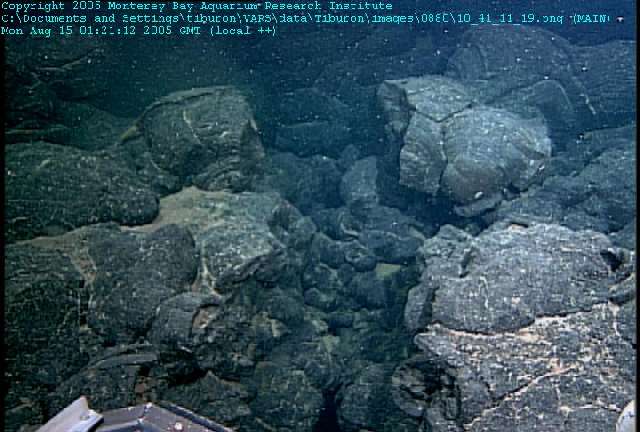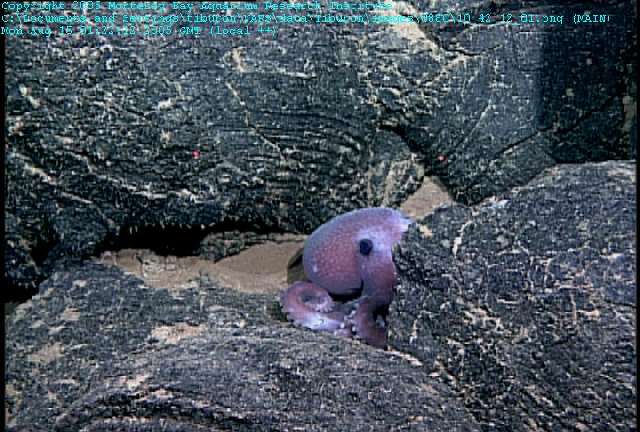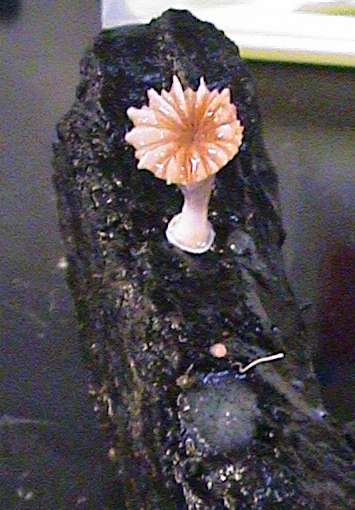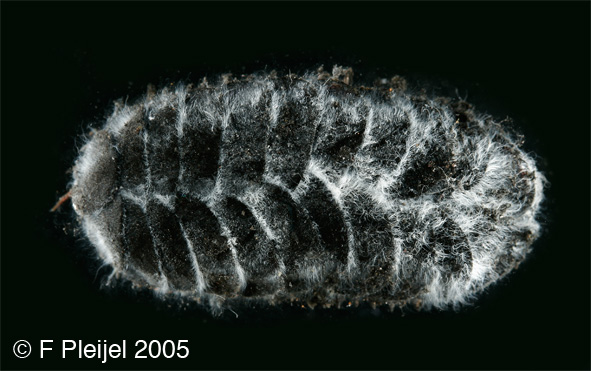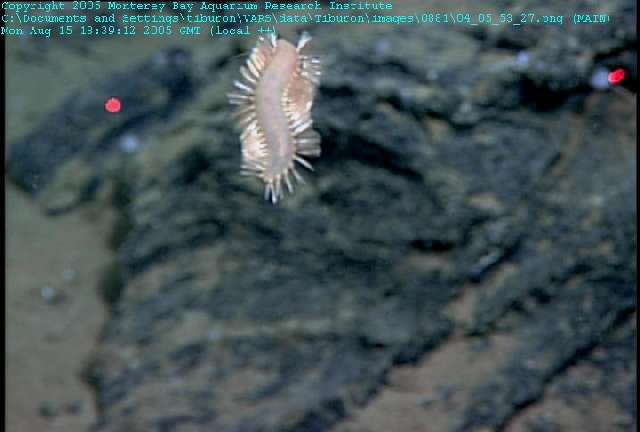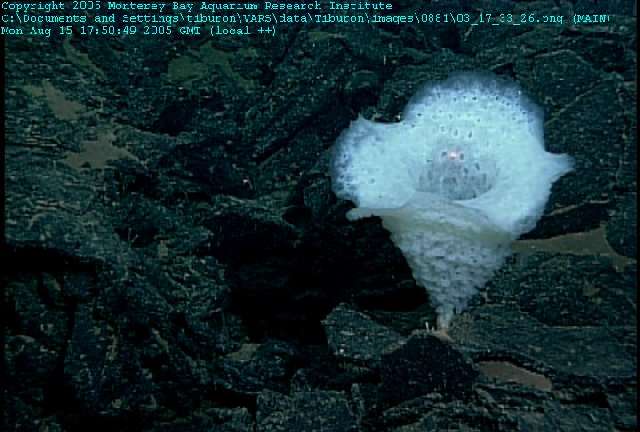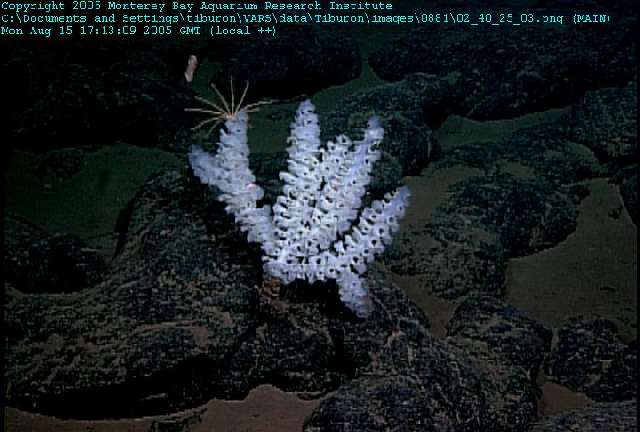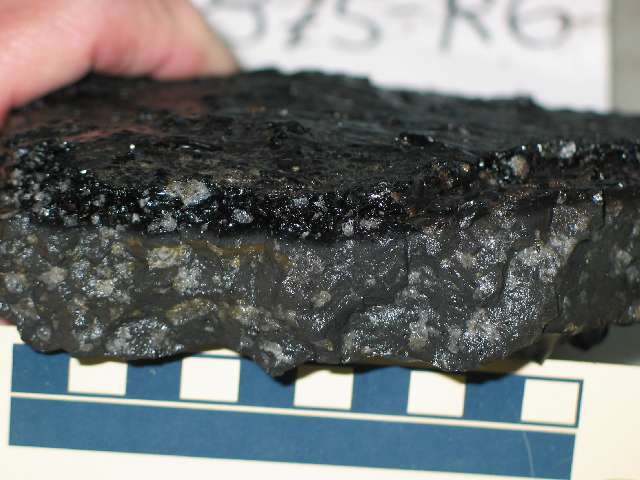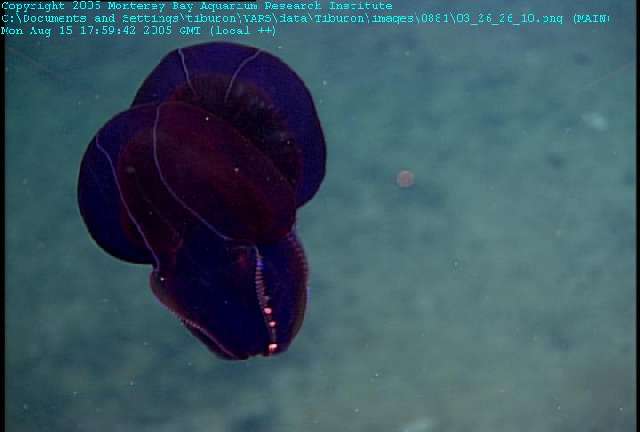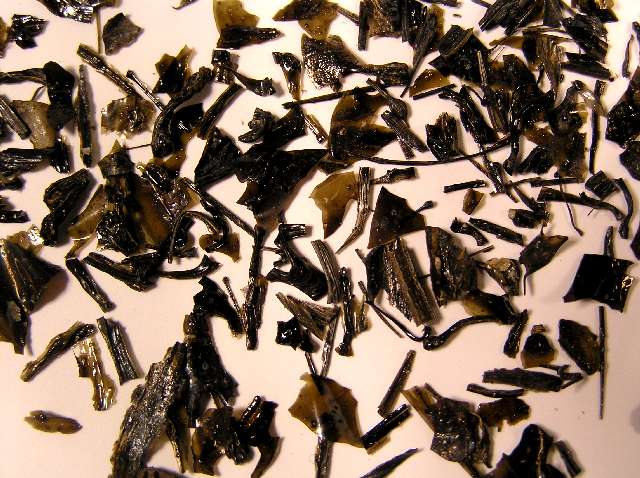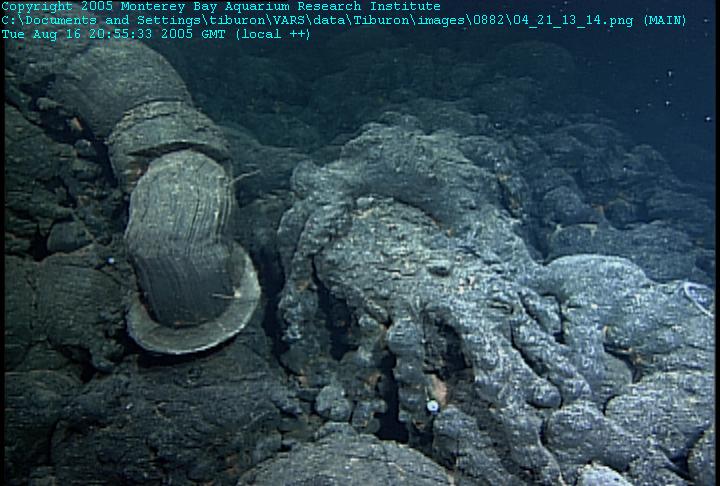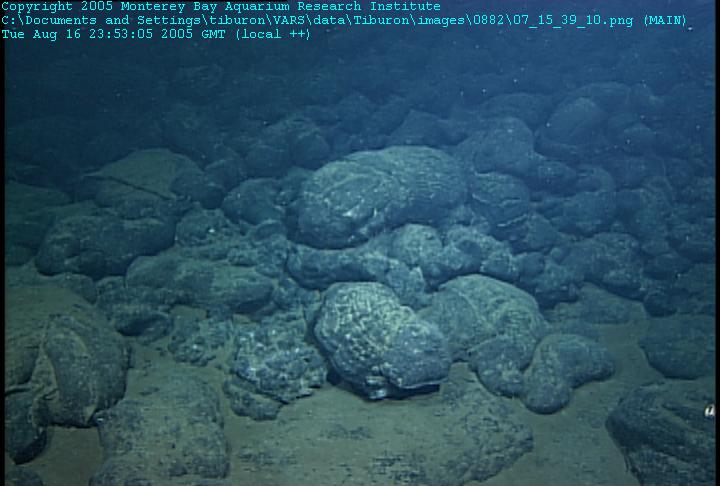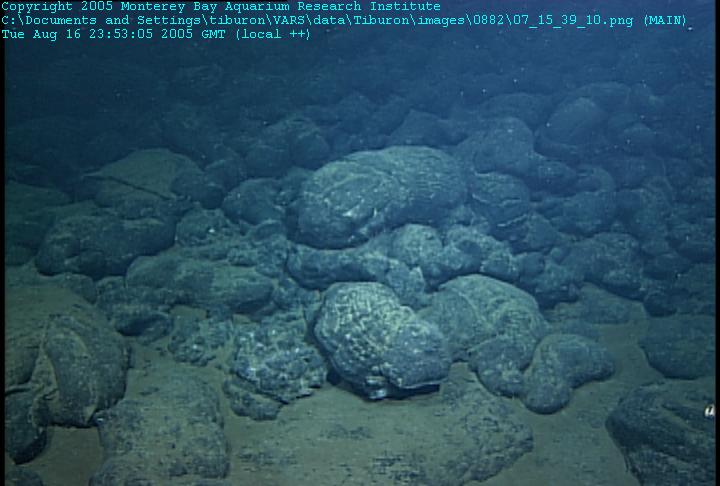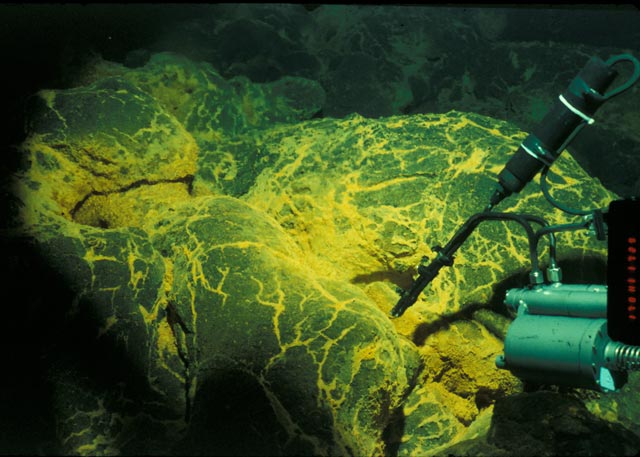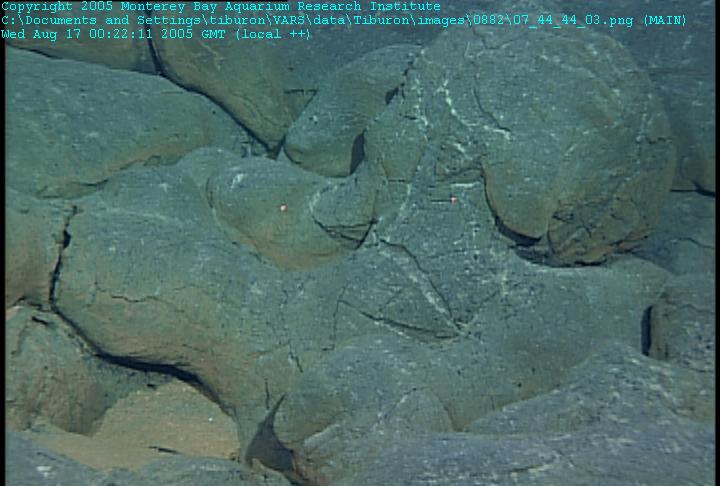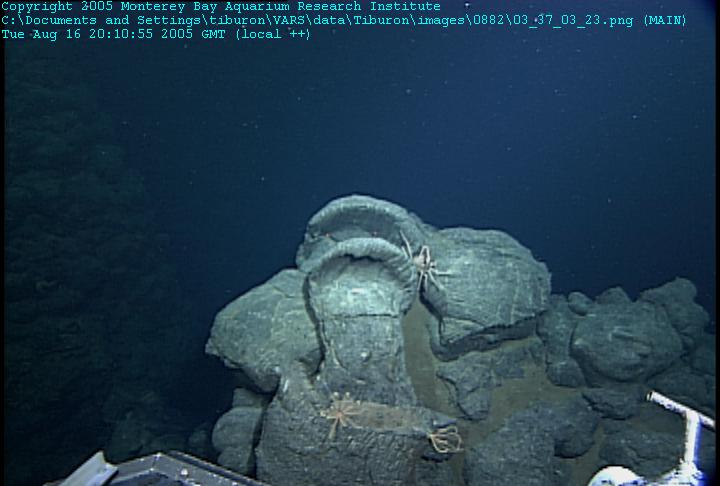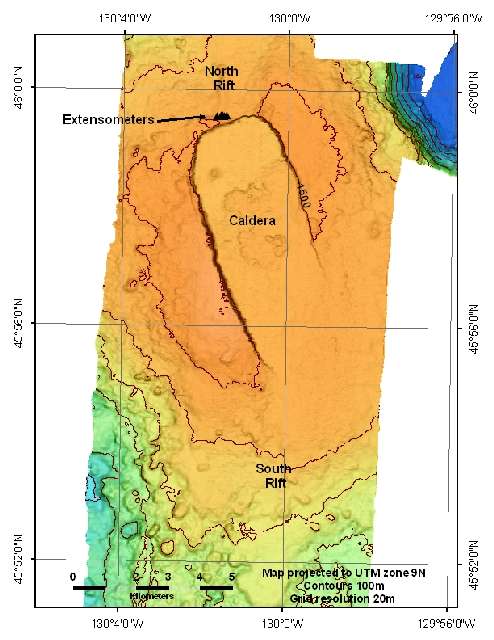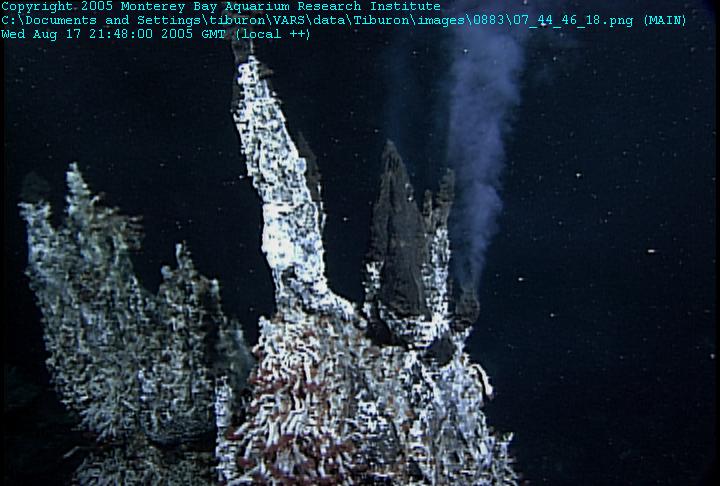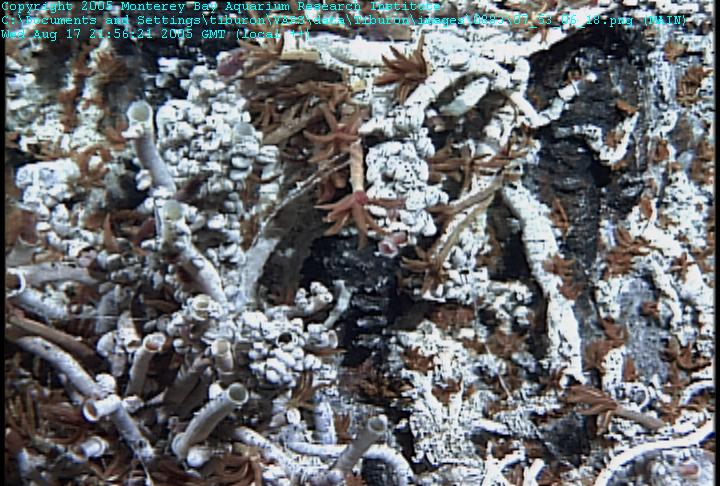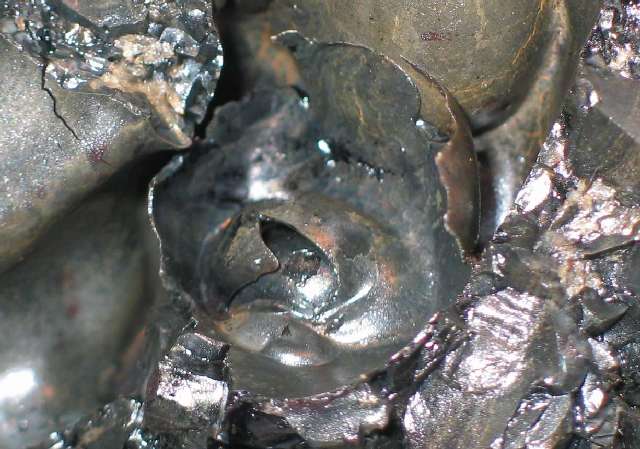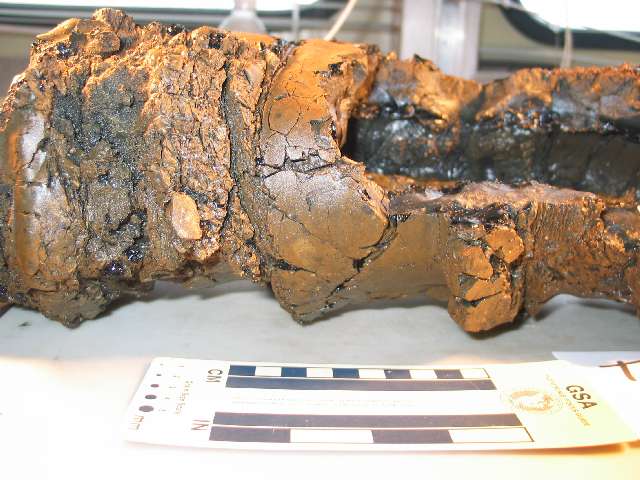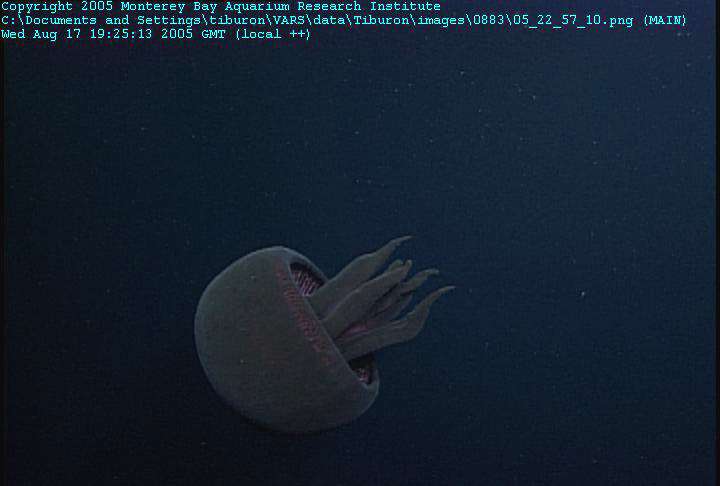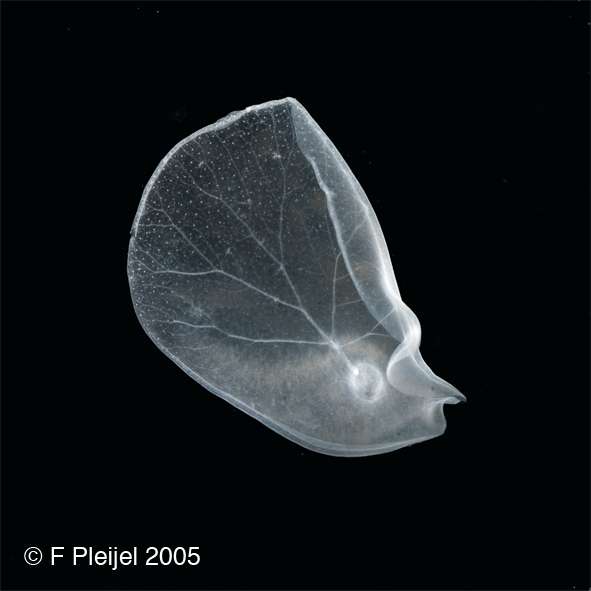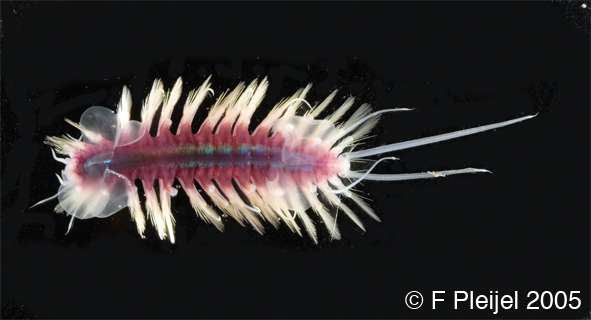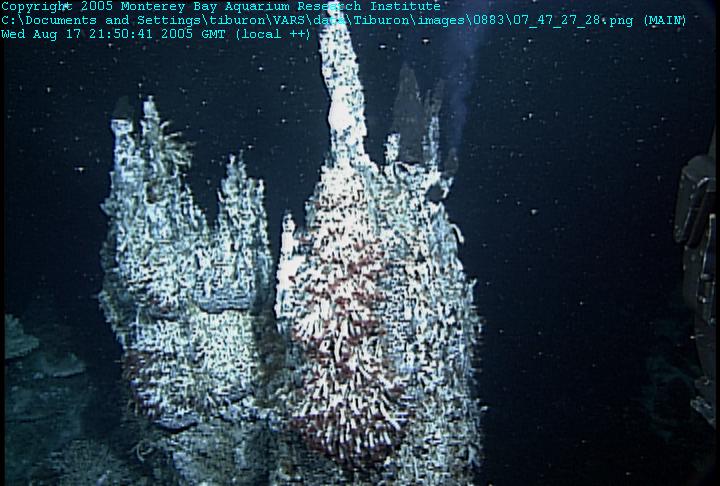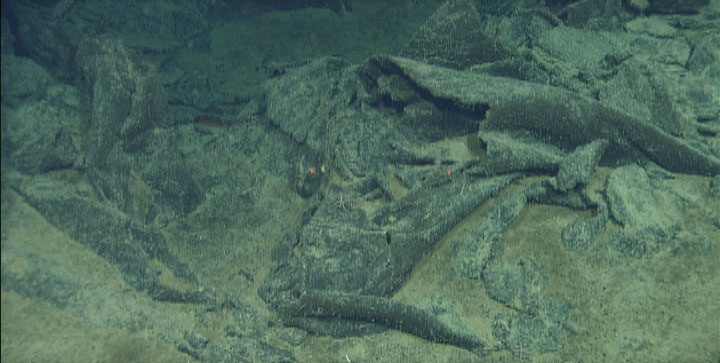 | Juan de Fuca |
CoAxial ridge. The older lavas surrounding the 1986 lava flow at north Cleft have sediment accumulated between the pillows and large sessile animals growing on them, such as this Gorgonian coral |
South rift zone of Axial Seamount - the large deep lava pond on the south rift zone of Axial Seamount. We wanted to determine where the lava that formed the ponds erupted and to examine the walls and floor of several more of the drained ponds. The dive was set up to start east of the pond complex to determine if any overflows had covered the region east of the pond. We landed on jumbled sheet flows and crossed several fault scarps on our way to the levee of one of the smaller ponds. The outer slope was entirely elongate pillow lavas that flowed down the steep slope. The rim was lobate and drained lobate flows with many collapses and the inside wall had horizontal shelves of lava that mark former surfaces of the lava pond as it drained. The floor of the first small pond was entirely talus blocks tumbled down the steep slopes on the inside of the drained pond. However, the second larger pond we entered had a complex floor with sheet flows, pillow lava, and jumbled sheet flows. |
vertical shafts lined with lava that may have been vents as well as a small (several meter tall) spatter deposit. The spatter was extremely delicate and difficult to sample, but we did recover several pieces that proved to be agglutinated spatter (spatter stuck together when still molten). Such deposits form during low spattering or fire fountains and demonstrate that the eruptions in the pond were mildly explosive. The abundant limu o Pele (bubble wall) fragments in all the sediment samples around the ponds also show that the lava was quite gas rich and that mild bubbling occurred during the eruption. |
Mound of spatter. The rock sample to the right was broken from the orifice in the center of the mound |
Spatter welded to a thin sheet of glassy lava (viewed edge-on), collected from the spatter mound to the left. The scale bar is in centimeters and inches |
Fissure that cracked apart the large, older pillow lavas on either side, then was filled with younger, blacker lavas that erupted through and covered the fissure with a large mound of pillows just out of view. |
Just as we were about to return to the surface, we found the second octopus (Graneledone) seen on the cruise. After he (she?) posed for pictures, we were on our way to the surface. |
Cup coral |
Possibly same species as one of the polynoid polychaetes in August 11 update, but this one is completely black. Bacteria on its surface make it look hairy. The animal is 2cm long. Photo by Fred Pleijel. |
Flabellegerid polychaete, above a sheet flow.-the submarine landscape I have seen on the Gorda Ridge (the ridge segment south of the Juan de Fuca Ridge) or on the seamounts offshore California, the landscapes on these dives have been the most dramatic I have seen on the ocean floor. Todays dive was the third on the unusual big lava pond complex on Axial Seamount. Like the previous dives, we traversed pillow talus covered slopes with varying amounts of sediment that surrounded depressions or craters. The craters were bounded by steep cliffs of truncated pillow and lobate lavas with drainage shelves. Most of the lava surfaces we traversed were exceedingly rough, and chaotic looking, resembling aa flows on Hawaii, but of extremely fluid lavas. Some mounds and spires appeared to be composed of spatter, and the samples we collected confirmed this, although spatter had been presumed not to be able to form at these depths. |
Vase-shaped sponge on a thin crust of a jumbled sheet flow. These fragile, glassy rocks would be ground to bits if sampled with a dredge, which is basically a heavy chain-mesh bag dragged on the seafloor and is the traditional way of sampling rocks on the sea floor. |
different white sponge on a lobate flow provides a perch for a crinoid. just above them. |
glassy rinds or consist entirely of volcanic glass, which means it cooled so rapidly in contact with cold seawater that it didn''t have time to crystallize. This is the best material to analyze because it represents the quenched melt composition. large number of crystals of the mineral plagioclase feldspar.Most mid-ocean ridge basalts include a few percent by volume of crystals, most commonly olivine and plagioclase, and the surrounding matrix is composed of extremely fine-grain crystals (can be seen only under a microscope) or glass due to the rapid cooling that these lavas undergo. Our lava pond flows include as much as forty percent plagioclase crystals, however, and the crystals are pretty big - as much as a centimeter in length! At the end of today''s dive, we climbed a small seamount adjacent to the lava ponds. The four samples that we collected from this seamount were "normal" looking mid-ocean ridge basalts, with just a few small crystals of feldspar. But these are the only "normal" basalts that we have seen in over fifty samples collected during three days of dives in this area. So why are all the lavas here so unusually rich in feldspar crystals? It''s possible that these crystals had slowly crystallized and accumulated in a cooling magma that sat below the surface of the lava ponds for an unusually long time, and this magma then erupted to form the lava ponds flows. An alternative is that the feldspars crystallized and accumulated in a subsurface magma body, but that a new magma intruded this body and dragged the crystals up to the surface. This has been known to happen elsewhere on mid-ocean ridges.We can use several techniques to distinguish between these two possibilities, all of which test whether or not the crystals are in chemical equilibrium with the surrounding host basalt glass. If they are not in chemical equilibrium, then we know that the lavas have picked up these feldspar crystals from elsewhere. This is a small project that I hope to work on over the next few months |
the Crown Jewels |
Our group has now found limu o Pele at sites as scattered as Loihi Seamount, Kilauea''s Puna Ridge, and the North Arch lava field in Hawaii; at mid-ocean ridges such as the Gorda Ridge, the East Pacific Rise near Baja California, at 21N, and near Easter Island; and in the back-arc Fiji Basin. A goal for this cruise was to determine if limu o Pele and related small lava fragments also occurred on the Juan de Fuca Ridge. They do! We have changed our goal somewhat: can we find a place here where we do NOT find abundant limu o Pele? These fragments are important because they demonstrate basaltic eruptions in all these settings are driven by a magmatic gas phase that makes their eruptions energetic-with low-level fountains and strombolian-like explosions similar to those that occur on land. The amounts of magmatic gas (mainly carbon dioxide) required to produce the abundant limu o Pele and drive the eruptions suggest that submarine volcanism adds much more carbon dioxide to the deep ocean than previously thought. The particles produced are dispersed in the water column and distributed unknown distances by near-bottom currents. Determining the dispersal pattern of these pyroclastic particles at two sites will be a major goal of the upcoming Gorda Ridge leg of this cruise |
Pele''s hair, a thread of lava glass pulled like taffy while still molten during a mildy explosive eruption, collected from 2300m depth in the lava pond. The lumps are probably plagioclase crystals the lava stretched around. The fragment is about 1cm long |
Tiburon dive 882, CoAxial Lava Flows, Juan de Fuca Ridge |
To see how the new flow surface has changed since it was seen in 1993. Contact today between the older flow (sediment covered, in the foreground) and the 1993 lavas (less sedimented and darker, beyond). |
To see how the new flow surface has changed since it was seen in 1993. Fresh lava pillows in 1993, during a ROPOS dive to CoAxial two weeks after the eruption. Photo courtesy of Bob Embley |
Pillow surfaces at the site of the eruption, 1993. Hydrothermal fluids emanating from cracks between lava pillows enable lush microbial growth. The equipment on the right is for sampling the fluids for temperature and water chemistry by the ROPOS. Photo courtesy of Bob Embley |
Lava surfaces today at the old vents. Some hydrothermal staining is visible on the surfaces between pillows, but the bacterial mats are gone |
brachyuan crab and two crinoids were spotted on this pillow at the edge of a large fracture. Note the heavy sediments that fill the cracks between pillows, a sign that this flow is older than the others we traversed today. Except where the sediments are derived locally such as hydrothermally active areas, or near land where turbidity flows can dump large volumes of material here and there, the rate of the gentle rain of pelagic detritus is relatively constant in any given region and can be used to estimate relative ages of surfaces.he high-temperature recorder that flooded during recovery from the hydrothermal vent at South Cleft! |
Tiburon dive 883 - Axial caldera, Juan de Fuca Ridge, the 1998 eruption of Axial seamount |
the CASM hydrothermal vent site, located in a deep fissure on the caldera floor. CASM was the first hydrothermal vent site found in the northeast Pacific during dives with the Pisces IV submersible in 1983, and some of the first collections of chemosynthetic vent animals on the Juan de Fuca Ridge were made here. The site seemed to have been rejuvenated by the 1998 Axial eruption, but had not been visited since 2001. At a vent called T&S Spires, we found vigorous venting along a row of chimneys covered with lush communities of tubeworms, palmworms, and numerous species of polychaete worms. Thus this vent field has remained active for at least 22 years. The tops of several active hydrothermal vent structures in the caldera of Axial Seamount. |
Alvinellid worms carpet the sides of the hydrothermal vents in the Axial caldera, nourished by the sulfide in the vent fluid |
Limu, in situ. A lava bubble within a bubble is preserved in a pocket of a piece of lava from a sheet-flow we collected today in the caldera of Axial Seamount. The outer bubble is 2 cm across |
Lava pillar we collected from a collapsed lava-pond at South Cleft. The scale bar is in inches and centimeters for scale |
A large jelly we affectionately call "Big Red" (Tiburonia granrojo), at Axial Seamount. This jelly has now been found at several of the seamounts off Central California and the East Pacific Rise as well. |
Scale from the polychaete above. The veins are vascular structures. The scale is 2mm across |
Dorsal view of polynoid polychaete (scaleworm) collected at an older CoAxial lava flow. The worm is 3 cm long |
A view of the CASM hydrothermal vents, with gray "smoke" exiting from the chimney in the right |
Tiburon dive T1010, Axial Seamount, Sheet flow of very fluid lava that erupted since the thick volcaniclastic sediments were deposited. This flow was very difficult to sample because the thin sheets were pure volcanic glass.We began the dive on the floor of the caldera so that we could observe the rock units exposed in the caldera wall on our way to the first vibracore location. Talus of mostly angular massive lava flows has accumulated at the base of the caldera wall, but upslope the wall consists of outcrop of massive jointed flows, pillow flows, and lobate flows. Every small shelf is covered with sand and gravel sized glass fragments. The massive flows form vertical sections up to perhaps 5 meters thick, but the pillow and lobate flows form less steep slopes. The entire section has been extensively fractured. Near the top we encountered several fractures that parallel. On Axial seamount, an active caldera located exactly on a mid-ocean-ridge, we sampled little piece of basaltic volcanic glass, produced by the volcano when the erupted hot lava was cooled extremely quick by the seawater. In those samples we found fascinating forms of glass pieces. Some in the shape of a hair, really not much thicker, some of them are even curled. Other fragments are thin plates with sharp edges, slightly bent, making them look like fragments of tiny beer bottles, since they are brownish transparent, too. The only drawback about most of the samples taken on the flanks of this volcano is, these were taken in long aluminium tubes by simply pushing them into the sediment and these are not to be opened on the ship |
|
from MBARI - http://www.mbari.org/expeditions/ridges2005/
Axial ridge. We continued the dive to the west of the large ponds to see if the lava that formed the ponds could have erupted from a fissure that formed a small N-S ridge. In between we crossed a region that was severely tectonized, with numerous faults and gaping fissures. Almost all the lava in this region was shattered. We proceeded to the northwest and explored several low lava shields surmounted with craters. We had thought that these would also turn out to be drained lava ponds, but both were collapse pits that truncated pre-existing flows. The dive ended on the small ridge where we followed an open fissure to the north until it was buried by a younger flow that filled the fissure and flowed south along it.
The discovery of spatter formed during a mid-ocean ridge eruption is novel and important in that it confirms our view that essentially all deep sea basaltic eruptions have a significant magmatic gas component and erupt more energetically than most researchers think. We will be keeping an eye out for similar deposits on our remaining dives.
To see how the new flow surface has changed since it was seen in 1993. Today the 1993 lava has aged a bit, with small amounts of sediment collected on the pillow surfaces. The vivid yellow microbial mats died off as the lava cooled within about a year of the eruptiontoday the former venting sites are still visible as a dull yellow surficial coating. Some life has returned to the lava surface and detailed analyses of the video data by MBARI scientists will reveal to what extent the colonization of this surface is taking place. This study is unique because there are only a few places on the deep seafloor whose birthday we know.
Polychaetes, or marine bristle worms (relatives to earthworms), occurred in abundance on the black smokers. Three groups of polychaetes dominated, scale-worms (Aphroditiformia), Pompeii worms (Alvinellidae), and vestimentiferan giant tube-worms (now Siboglinidae; see below).
Several different scale-worms were found (image on right is 3 cm long), some with dense bacterial mats completly covering the scales of the animals. Whereas most scale- worms are predators on small invertebrates, the feeding biology of these animals is currently unknown, as is the actual relationships with the bacterial mats. Many shallow water scale-worms live in association with tube-living animals, and this is likely the case also here, as they were found in large numbers among the tubes of the alvinellids and the siboglinids.
Whereas deep-sea marine invertebrates generally live in very cold water (around 0°C) and die quickly if exposed to higher temperatures, hydrothermal vent animals can stand impressing variations in temperature. Alvinellids, which live on the smokers near the orifices where the hot water emerges have been recorded to stand temperatures up to about 80°C! These animals live in tubes, densely aggregated around the smokers. They feed on particles with the help of a large number of extensible tentacles, possibly also with the help of the eight large gills, probably mainly on the abundant chemoautotrophic bacteria. When occurring in dense aggregations they show quite a bit of aggressive behavior towards the neighbors, trying to tear them out of their tubes! The group was discovered in the 1980s and, as far as known, occur only in association to hydrothermal vents in the Pacific.
The siboglinids have an interesting taxonomic history. They include two groups which earlier by some researchers were given the taxonomic status of phyla, Pogonophora and Vestimentifera. For a long time they were believed to be closely related to group such as echinoderms, acorn worms etc, although this has in recent years been show to be incorrect, and today these two phyla have been reduced to the single family Siboglinidae within the polychaetes. One reason for this misinterpretation is that siboglinids lack both mouth and gut and that they for nutrition rely completly on bacteria living in the body. This lack of gut, together with an otherwise also highly aberrant morphology (compared to other polychaetes), effectively masked the identity of the group. Based on a full reinterpretation of the their morphology, coupled to DNA analyses, we now are certain of their position. The most recent addition (and no less odd animals) are the siboglinids described from sunken whale carcasses in deep waters off California, forming root systems in the bones where they extract and live of the whale oils with the help of symbiotic bacteria.
